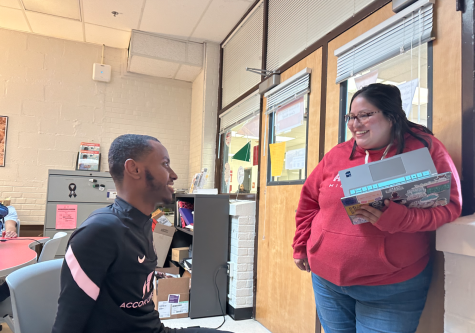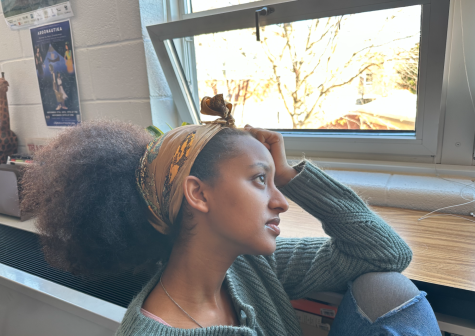Turf Wars
Athletes weigh pros and cons of artificial fields
Spring sports are beginning, which means dozens of athletes will be running on AHS’s new turf fields. They were installed less than two years ago, and some athletes are already missing the grass fields.
“On grass fields, the atmosphere is better, it is easier to dive for the ball and make risky plays without having to worry about turf burn,” varsity lacrosse captain senior Jon Figley said. “They also don’t get so hot as easily.”
AHS was one of the last high schools in Fairfax County to get turf fields. According to Director of Student Activities, John Ellenberger, the total cost for the two turf fields that were installed was $1.6 million.
This money came from several different groups. The Fairfax County Board of Supervisors and Neighborhood and community services were responsible for $750,000. Fairfax County Public Schools were responsible for $750,000. Annandale Boys and Girls Club donated $70,000 and use the field frequently for their practices. Lastly, Annandale Athletics Booster Club donated $89,000.
The booster club also gives $15,000 each year to be set aside for maintenance.
“The biggest reason for the switch from grass [fields] to turf is playability. Games are no longer cancelled due to unplayable field conditions,” Ellenberger said.
Turf fields have been replacing grass fields since 1965. Turf allows athletes of all sports to play while it is raining and grass gets too muddy. Turf also allows for several games in a row to be played while grass gets torn up from cleats and needs to grow back.Turf takes less work to maintain, grass needs to be mowed and treated every few weeks to keep it nice.
“I like turf better because it is flat and easier to run around on without problem as opposed to grass where there could be holes or missing grass patches,” varsity lacrosse captain senior Melissa Wilson said. “Turf also makes it possible to practice in many weather conditions. Grass gets too muddy and it’s gross.”
Although there are all these advantages to turf, there are several important downsides.
Athletes understand just how hot turf can get. Turf fields can get to 170 degrees during the warmer months, and players can feel that when on the fields.
“Turf gets really hot in the spring and summer and I can feel the heat through my cleats, so my feet get hot too,” Wilson said.
Since turf has become popular, doctors have seen an increase in injuries on the field.
Turf fields, made of synthetic (plastic) grass and rubber tire pebbles, have been attacked in recent years for causing cancer and increasing the risk of injuries.
“Yes, injury rates have definitely gone up,” Athletic Trainer Bethany Osborne said.
A study from the Orthopedic Journal of Sports Medicine released a study in 2016 where they tested soccer players for 12 years on both grass fields and artificial turf fields.
“Statistics have shown that injury rates are higher on turf especially with ACLs because your foot almost gets caught in the turf, and your body twists while your foot is caught,” Osborne said.
The study revealed that there was a significant increase in both upper and lower extremity injuries. They also discovered that there was a high muscle strain on the lower extremities. Once more turf pellets were added to the field, the muscle strain slowly decreased.
“I like running on turf better because the ground gives more and feels better on my feet and shins,” Wilson said.
Another common injury among athletes is turf burn.
“Wound care rates have gone up as well because turf burn and things like that,” Osborne said.
Turf burn is the result of falling or sliding across the fake grass. A turf burn injury generates heat while also ripping off a layer of skin. You receive a nasty cut or bruise that resembles a severe rug burn.It is painful and can take a long time to heal.
“I don’t like turf because I get turf burn,” Varsity Lacrosse Captain and senior Grace Hatch said.
The University of Washington discovered that several of their soccer players had been diagnosed with cancer, especially those who played as goalie. The university found that the chemicals found in tire rubber can be harmful to people when exposed at high levels.
Fifty-three soccer players from the University of Washington were diagnosed with cancer, many of them were blood cancers. 60% of them were goalies.
Some claim that when the turf pellets are inhaled or ingested, the toxins in the turf cause cancer. Goalies are on the ground more and have more contact with the turf than other players do, which is why blood cancer occurs more frequently in goalies.
Although this data seems important, the health department at the university found that the link between turf and cancer is not significant. Despite this, many athletes and parents are against turf fields. Coaches at the university have requested more studies.
“I like turf fields better than grass fields because the soccer ball moves smoother,” junior Alison Scott said.
Despite being popular in fields because of the low cost, artificial turf fields are not popular among athletes and parents because of the injury prone and cancer questions surrounding it.

Senior, Rachel Shogren has been on staff with The A-Blast for four years. She is the Health Editor this year and was previously the Academics Editor and...






